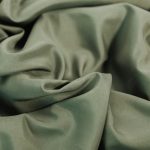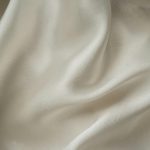You’ll find crepe fabric is great for summer thanks to its lightweight feel and breathable texture. It naturally wicks moisture away from your skin, keeping you dry and comfortable even on hot days. Crepe’s tiny air pockets boost airflow, helping prevent sweat buildup and clinginess. Unlike some fabrics, it resists wrinkles and stays fresh longer. If you want to explore how crepe compares to other summer materials and how to style and care for it, there’s more to discover.
Table of Contents
Key Takeaways
- Crepe fabric is lightweight and breathable, making it comfortable for hot summer days.
- Its unique texture creates tiny air pockets that enhance airflow and reduce sweat retention.
- Crepe absorbs moisture quickly and dries faster than many fabrics, keeping skin dry and comfortable.
- Compared to cotton and linen, crepe is wrinkle-resistant and maintains breathability without clinginess.
- Loose-fitting, light-colored crepe garments improve ventilation and reflect sunlight for added summer comfort.
Understanding Crepe Fabric and Its Variants
Crepe fabric offers a unique texture that sets it apart from other materials, making it a popular choice for summer wear. When you feel crepe, you’ll notice its slightly crinkled, pebbly surface that adds visual interest without bulk.
It comes in several variants like silk crepe, wool crepe, and polyester crepe, each with distinct qualities. Silk crepe feels lightweight and breathable—perfect if you want cool comfort. Wool crepe, though less common in summer, is slightly heavier but still breathable.
Synthetic versions, like polyester crepe, offer durability and wrinkle resistance but may trap heat. Understanding these differences helps you pick the right crepe fabric that balances style, comfort, and breathability for your summer wardrobe.
How Crepe Fabric Is Made
The unique texture you enjoy in crepe fabric comes from a special weaving process combined with twists in the yarns.
When making crepe, manufacturers use highly twisted yarns, often called crepe yarns, which create a crinkled or pebbly surface. These yarns are woven together using techniques like plain weave or satin weave, causing the fabric to have that distinctive grainy feel.
You’ll find crepe made from various fibers, including silk, wool, cotton, and synthetic blends, each affecting the texture slightly.
After weaving, the fabric may undergo finishing processes like steaming or washing to set the texture and enhance its drape.
This method gives crepe fabric its unique look and feel, setting it apart from smoother textiles you might be used to.
Breathability Features of Crepe Fabric
You’ll appreciate how crepe fabric’s moisture-wicking properties keep you dry on hot days.
Its unique texture allows for excellent airflow and ventilation, helping your skin breathe.
Plus, the fabric’s lightweight nature plays a big role in staying cool and comfortable all summer long.
Moisture-wicking Capabilities
When summer heat ramps up, fabrics that pull moisture away from your skin make all the difference. Crepe fabric, with its unique weave, helps wick sweat efficiently, keeping you dry and comfortable. This moisture-wicking trait prevents clinginess and reduces irritation, making crepe a smart choice for hot days.
| Feature | Benefit | You’ll Notice |
|---|---|---|
| Moisture-wicking | Draws sweat from skin | Dry, fresh feeling |
| Quick-drying | Speeds evaporation | Less dampness |
| Lightweight | Supports airflow | Comfort without weight |
| Textured weave | Enhances moisture flow | Reduced stickiness |
Airflow and Ventilation
Beyond moisture-wicking, crepe fabric excels at promoting airflow, which keeps you cool during sweltering summer days. Its unique texture creates tiny air pockets that enhance ventilation, allowing your skin to breathe naturally.
When you wear crepe, you’ll notice:
- Improved air circulation that prevents heat buildup, making hot days more bearable.
- Gentle fabric movement that encourages fresh air to flow around your body.
- Reduced sweat retention, so you stay dry and comfortable longer.
This breathable nature means crepe fabric won’t cling uncomfortably or trap heat like some synthetic materials.
You’ll appreciate how effortlessly it lets your body regulate temperature, making it a smart choice for summer. Choosing crepe means choosing comfort without sacrificing style or breathability.
Fabric Weight Impact
Although crepe fabric is known for its breathability, the weight of the material plays an essential role in how effectively it keeps you cool. Lightweight crepe allows better airflow, making it ideal for hot summer days. Heavier crepe, while still breathable, can trap more heat and may feel warmer against your skin. When choosing crepe for summer, consider the fabric weight to balance comfort and durability.
| Fabric Weight (gsm) | Breathability Level | Ideal Use |
|---|---|---|
| 100-150 | High | Summer tops, dresses |
| 150-200 | Moderate | Lightweight trousers |
| 200-250 | Low to Moderate | Jackets, structured wear |
Pick a lighter weight crepe for maximum coolness during summer activities.
Moisture-Wicking Properties of Crepe
You’ll appreciate how crepe fabric absorbs moisture quickly and dries faster than many other materials.
This means you stay comfortable and dry even on the hottest days.
Understanding these moisture-wicking properties helps you choose the best fabric for skin comfort all summer long.
Crepe’s Moisture Absorption
When you wear crepe fabric in the summer, you’ll notice how it efficiently pulls moisture away from your skin. This absorption ability keeps you feeling fresh and dry, even on the hottest days.
Crepe’s unique weave allows it to:
- Quickly absorb sweat without feeling heavy or sticky, so you stay comfortable.
- Prevent moisture buildup, reducing that clammy sensation you hate.
- Help regulate your body temperature by managing wetness, keeping you cool.
Because crepe fabric manages moisture so well, you can enjoy longer periods outdoors without discomfort.
Its natural breathability combined with moisture absorption makes it a reliable choice for summer clothing. You’ll find yourself reaching for crepe when you want to stay cool, dry, and confident all day long.
Drying Speed Comparison
Since crepe fabric absorbs moisture so effectively, it also dries faster than many other summer textiles. When you wear crepe on a hot day, sweat doesn’t linger, keeping you feeling fresh.
Compared to cotton, which can stay damp longer, crepe’s unique weave allows air to circulate, speeding up evaporation. Silk crepe dries quickly too, but it’s often less durable for everyday use.
Synthetic fabrics like polyester might wick moisture but tend to trap heat, making drying slower and less comfortable. Crepe strikes a balance by pulling moisture away from your skin and releasing it swiftly into the air.
Impact on Skin Comfort
Although many fabrics claim to wick moisture, crepe stands out by keeping your skin dry and comfortable throughout the day. Its unique weave allows it to absorb sweat quickly and release it, preventing that sticky, clammy feeling you hate in the heat.
When you wear crepe, you’ll notice:
- Reduced irritation — the fabric’s breathability minimizes sweat buildup, so your skin stays calm and rash-free.
- Constant freshness — moisture wicks away efficiently, leaving you feeling cool even during intense summer activities.
- Enhanced confidence — no more worrying about sweat stains or clinginess; crepe maintains a smooth, polished look.
Choosing crepe means you’re investing in comfort that protects your skin, letting you enjoy summer without the usual discomforts.
Comparing Crepe to Other Summer Fabrics
While choosing the right fabric for summer, you’ll find crepe stands out for its unique blend of texture and breathability compared to other popular options like cotton, linen, and chiffon.
Crepe offers a slightly crinkled texture that helps wick moisture away, keeping you cool without feeling clingy. Cotton is breathable and soft but can sometimes retain sweat, making it less ideal in extreme heat.
Linen excels in airflow but wrinkles easily, which mightn’t suit your style preferences. Chiffon feels light and airy but isn’t as durable or opaque, limiting its use.
Crepe strikes a balance by being breathable, lightweight, and wrinkle-resistant, making it a versatile choice when you want comfort without sacrificing appearance during hot summer days.
The Role of Fabric Weight in Summer Comfort
When you pick summer fabrics, the weight plays a crucial role in how comfortable you feel throughout the day. Lighter fabrics let air flow freely, keeping you cool and sweat-free. Heavier fabrics trap heat and moisture, making you uncomfortable and sticky. Crepe fabric varies in weight, so choosing the right one matters.
Consider these points when selecting crepe for summer:
- Lightweight crepe breathes well and feels soft, perfect for hot days.
- Medium-weight crepe offers durability but might retain some warmth.
- Heavyweight crepe can feel restrictive and trap heat, best saved for cooler days.
Styling Crepe Clothing for Hot Weather
How can you stay stylish without overheating in crepe clothing during hot weather?
Opt for loose-fitting crepe pieces that allow air circulation and prevent clinginess. Choose light colors like white, pastels, or soft neutrals to reflect sunlight and keep you cooler.
Pair crepe tops with breathable bottoms such as linen shorts or cotton skirts to balance comfort and style. Accessorize minimally—think lightweight scarves or simple jewelry—to avoid adding heat.
When selecting crepe dresses, go for sleeveless or short-sleeve designs with breathable lining. You can also mix crepe with other natural fabrics to enhance airflow.
Finally, don’t forget wide-brim hats and sunglasses to protect yourself while maintaining a chic, summer-ready look. This approach lets you enjoy crepe’s elegance without sacrificing comfort.
Care Tips to Maintain Crepe Fabric in Summer
To keep your crepe fabric looking fresh throughout the summer, you’ll need to handle it with care that suits warmer conditions.
Crepe is delicate and requires gentle treatment to maintain its texture and breathability.
Crepe’s delicate nature calls for gentle care to preserve its unique texture and breathable quality.
- Wash with care: Use cold water and a mild detergent to avoid shrinking or damaging fibers. Hand wash or choose a gentle cycle if machine washing.
- Avoid direct sunlight: Dry your crepe garments in the shade to prevent fading and weakening of fibers caused by intense sun exposure.
- Iron on low heat: If needed, iron your crepe fabric inside out on a low setting to prevent shine or burns. Use a pressing cloth for extra protection.
Following these simple steps will keep your crepe garments comfortable and vibrant all summer long.
Ideal Summer Occasions for Wearing Crepe
You’ll find crepe fabric perfect for casual daytime events thanks to its breathable texture and stylish look.
It also works great for evening summer gatherings, offering comfort without sacrificing elegance.
Plus, crepe is a smart choice for outdoor formal occasions where you want to stay cool and polished.
Casual Daytime Events
When you choose crepe fabric for casual daytime events, you’re opting for comfort and style that keep up with the summer heat.
Crepe’s lightweight, breathable nature makes it perfect for occasions where you want to look effortlessly chic without feeling overheated. Whether you’re heading out for a brunch or a stroll in the park, crepe adapts beautifully.
Here are three ideal casual daytime events for wearing crepe:
- Weekend farmers’ markets — stay cool while exploring fresh produce and crafts.
- Casual outdoor lunches — enjoy the breeze without sacrificing your outfit’s flow.
- Daytime meetups with friends — move freely and comfortably during relaxed social moments.
Crepe’s wrinkle-resistant and soft texture guarantees you look fresh and feel great all day long.
Evening Summer Gatherings
Although evening summer gatherings often call for a touch of elegance, crepe fabric strikes the perfect balance between comfort and sophistication. You’ll appreciate its lightweight feel and subtle texture, keeping you cool without sacrificing style. Whether it’s a garden party or a casual dinner, crepe adapts beautifully to various settings.
| Occasion | Why Crepe Works |
|---|---|
| Garden Parties | Breathable yet dressy fabric |
| Casual Dinners | Soft drape with a polished look |
| Rooftop Cocktails | Lightweight for warm, breezy nights |
| Art Gallery Openings | Elegant texture complements creative vibes |
Choose crepe for evening events, and you’ll stay comfortable while looking effortlessly chic.
Outdoor Formal Occasions
How do you stay comfortable and stylish during outdoor formal events in the summer? Choosing crepe fabric is a smart move. It balances breathability with elegance, keeping you cool without sacrificing sophistication. Here’s why crepe works perfectly:
- Lightweight Yet Structured – Crepe drapes beautifully, giving you a polished look without the heaviness that traps heat.
- Moisture-Wicking – It helps manage sweat, so you feel fresh even as temperatures rise.
- Wrinkle Resistance – Outdoor events demand long-lasting style, and crepe holds its shape, ensuring you look sharp from start to finish.
When attending weddings, garden parties, or upscale brunches under the sun, crepe fabric keeps you comfortable and chic all day long.
Environmental Impact of Crepe Fabrics in Summer Use
Because crepe fabrics are popular for summer wear, it’s important to understand their environmental impact.
When you choose crepe made from natural fibers like silk or cotton, you support renewable resources and biodegradable materials, which are kinder to the planet.
However, synthetic crepe, often made from polyester or nylon, relies on fossil fuels and doesn’t break down easily, contributing to pollution.
Synthetic crepe fabrics depend on fossil fuels and resist decomposition, leading to long-term environmental pollution.
Also, production processes for synthetic crepe can release harmful chemicals.
To reduce your environmental footprint, look for crepe fabrics labeled organic or recycled.
You can also extend the life of your garments by caring for them properly.
Frequently Asked Questions
Can Crepe Fabric Cause Skin Allergies in Summer?
You might experience skin allergies from crepe fabric if you have sensitive skin or if the fabric is treated with chemicals. Always check the material’s quality and wash it before wearing to reduce irritation risks in summer.
Is Crepe Fabric Suitable for Active Outdoor Sports?
Crepe fabric isn’t ideal for active outdoor sports because it lacks moisture-wicking properties and can trap heat. You’ll want something more breathable and stretchy to keep you comfortable during intense physical activities.
How Does Crepe Fabric Perform in Humid Climates?
You’ll find crepe fabric doesn’t wick moisture well, so in humid climates, it might feel sticky and heavy. It’s breathable but not the best choice if you want to stay dry and comfortable all day.
Can Crepe Fabric Be Dyed at Home Safely?
You can totally dye crepe fabric at home without turning your space into a wild paint splash zone! Just use mild dyes, follow instructions carefully, and protect surfaces—you’ll get vibrant colors without any messy disasters.
Does Crepe Fabric Shrink After Washing in Summer?
You might notice crepe fabric shrinking slightly after washing, especially if you use hot water or high heat drying. To avoid this, wash it in cold water and air dry or use a low heat setting.
- Does Chiffon Fabric Stink - July 15, 2025
- Does Chiffon Fabric Affect the Economy - July 15, 2025
- Does Cotton Fabric Have a Nap - July 15, 2025







